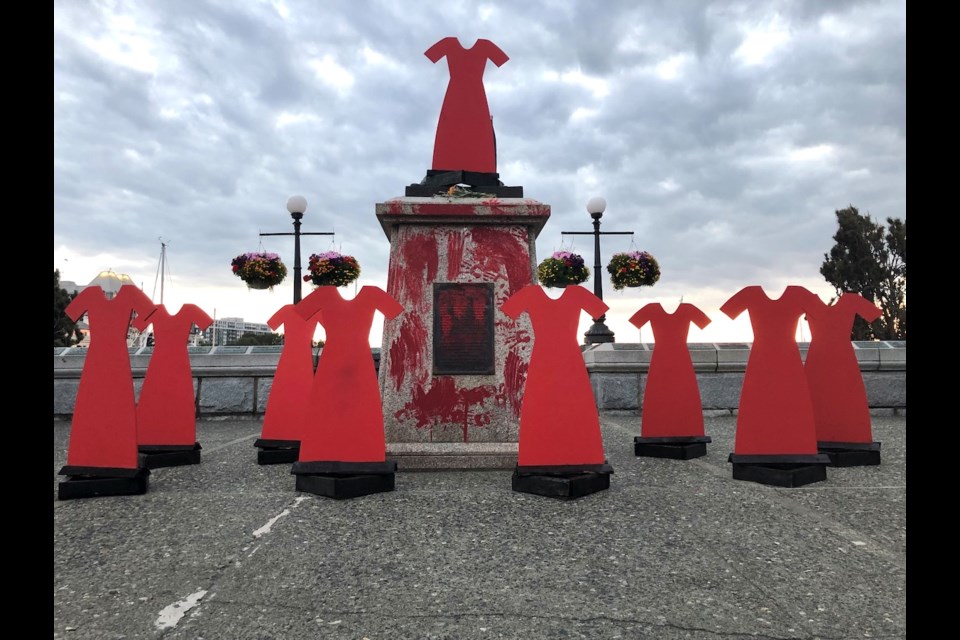A statue of Capt. James Cook was hauled out of Victoria’s Inner Harbour on Friday, a day after it was torn down and tossed into the water.
About 8 p.m. on Thursday, a crowd of 200 or so on the B.C. legislature lawns moved toward the statue of Queen Victoria. Diverted by police, the crowd went to the Cook statue on the upper causeway, across from the Fairmont Empress Hotel. A rope was slipped around the statue’s neck, and it was pulled down and thrown into the water below.
In the statue’s place, the crowd erected a wooden red dress, a symbol representing murdered and missing Indigenous girls and women. More wooden red dresses were erected around the statue’s base, and the pedestal was smeared with red handprints.
Police saw the statue come down.
No arrests were made.
On Friday, tarps were tied around the base and the wooden dresses had been removed.
The Greater Victoria Harbour Authority, which owns the statue, had it pulled out of the harbour.
CEO Ian Robertson said: “We do not condone vandalism of public or private property and will support the Victoria Police Department in their investigation of this incident.”
He said the GVHA stands in solidarity with the Esquimalt Nation and Songhees Nation — both members of the harbour authority — and it has worked to support the “economic and cultural aspirations” of the First Nations across its properties.
The statue was due to be discussed at an upcoming meeting of the GVHA’s First Nations economic development committee. Robertson said the future of the space will be decided “between our organization and the Esquimalt Nation and Songhees Nation, and we will communicate plans for it when the discussion is concluded.”
Police said they had been dealing with a report of a missing nine-year-old child when Thursday’s incident unfolded and had focused their efforts on closing the streets to traffic, ensuring the public and officers remained safe, and collecting evidence of the property damage occurring.
“Safe, peaceful and lawful protests are permitted under the Canadian Charter of Rights and Freedoms,” said police media officer Bowen Osoko. “Property damage is not.”
Const. Cam MacIntyre said an earlier gathering of thousands of people wearing orange “Every Child Matters” T-shirts — was “a moving, profound and thought-provoking” event and there was no indication that a raucous crowd would later gather around the Cook statue.
Sasha Perron, 27, who ran 215 kilometres in June in honour of residential school children and who organized the earlier event, said he is not affiliated with the group that removed the statue and that kind of activism is not his way.
Perron said the form of activism he wants to model and pass on is one of learning his language, culture, traditions and stories. “That is activism in itself because that’s what the government was trying to take away,” said Perron.
Perron said his event, carefully planned with family, was about building community and inspiring people. He expressed hope that people who wear an “Every Child Matters” T-shirt in memory of residential school children will act in a way that reflects the sanctity of that message.
In recent weeks, hundreds of grave sites of children who were forced into residential schools have been found through the use of ground-penetrating radar at or near three former residential school sites in Kamloops, Cranbrook and east of Regina.
Statues in Manitoba, Ontario and Newfoundland were also targeted on Thursday.
In Winnipeg, statues of Queen Elizabeth and Queen Victoria were tied with ropes and toppled during a rally about the deaths of Indigenous children at residential schools. A statue of Queen Victoria in Kitchener, Ont., was doused in red paint. In St. John’s, a statue honouring police was marked with red paint.
University of Victoria professor Paul Bramadat, who is working with others on a book related to Indigenous spiritualities in the public arena, said he does not necessarily condone the destruction of the Cook statue, but added that one can hardly be surprised when such statues are taken down.
“Given the horrific discoveries over the last month and the long history of trauma we’re understanding better and better, many of my colleagues and I are surprised that these statues have remained where they are for so long,” Bramadat said.
Several suspects sought after Captain Cook statue damaged last night. Here are 2 of them. Safe, peaceful & lawful protest is enshrined in the Charter of Rights & Freedoms. Property Damage is not. Recognize them? Call (250) 995-7654 ext 1. | #yyj https://t.co/TCwrM6QYDU pic.twitter.com/WLtqJNOf5b
— Victoria Police (@vicpdcanada) July 2, 2021



